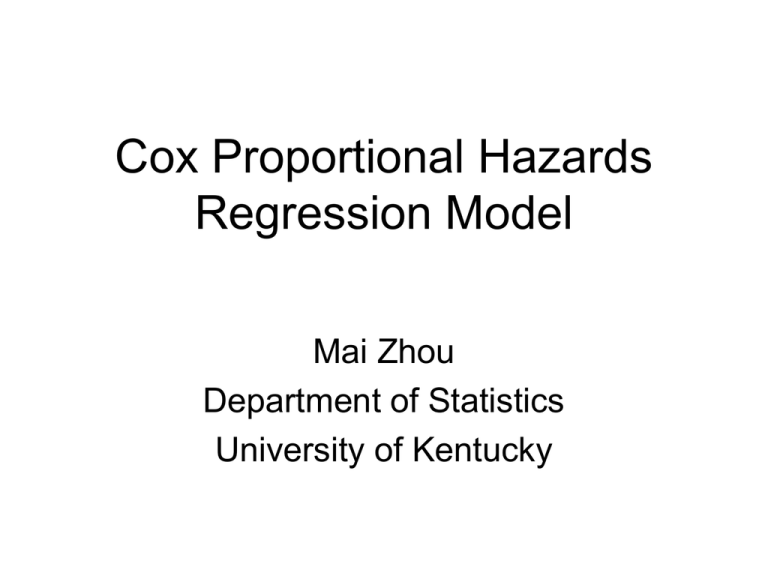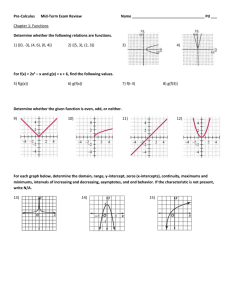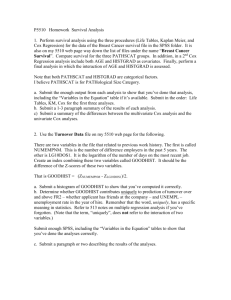Power point file. - University of Kentucky
advertisement

Cox Proportional Hazards Regression Model Mai Zhou Department of Statistics University of Kentucky A search in the New England Journal of Medicine, Nov. 2001 --- Nov. 2002 article for “Cox proportional hazards” yield >300 results. A search in Journal of American Medical Association yields similar result. Some quotes from abstracts of NEJM: ..The time to cancer in the two groups was compared by Kaplan–Meier analysis and a Cox proportional-hazards model ……(5/2002) The presence of an interaction between sex and digoxin therapy with respect to the primary end point of death from any cause was evaluated with the use of Mantel–Haenszel tests of heterogeneity and a multivariable Cox proportional-hazards model, adjusted for demographic and clinical variables. (10/2002) With the use of Cox proportional-hazards models, the body-mass index was evaluated …… (8/2002) We used proportional-hazards regression models to estimate the effect on mortality of combination therapy …… (11/2001) Methods We estimated graft survival using proportional-hazards techniques, adjusting for patient and donor characteristics, for a series of 30,564 Medicare patients receiving …. Methods In this prospective cohort study, we estimated the effects of air pollution on mortality, while controlling for individual risk factors. Survival analysis, including Cox proportional-hazards regression modeling, was conducted with data……. Exponential Random Variable • Two ways of describing an Exponential random variable. 1. Length of “life”… X CDF, pdf 2. Force of mortality, hazard, risk, intensity. Hazard at time t Imaging some evil force try to kill you: at time intensity of the force is h(t ) [ must 0 The probability you die in the next small time interval (t , t t ] (provided you still alive at time t ) is h(t )t t the ]. h(t ) • If distribution. constant, then we get Exponential • Easiest in the language of hazard. • But may not be appropriate for many cases. OK to describe an electric component under constant working condition. But my hazard goes up if I am going through a high stress time, downhill skiing…… • Average US population daily hazard based on 2000 census is bath-tub shaped. Exponential Regression Model • Every patient’s lifetime is an exponential r.v. • The only difference is the constant hazard. This patient is female, young and have no family history of heart problems --her risk (constant) is low. (or 20% lower …) • Constant for patient i, depends on , i his/her covariates (gender, age, gene …..) Exponential regression Model (cont.) • The constant hazard for patient i is i exp( 1agei 2 genderi 3trti ) The exp( ) is used to ensure the constants are always positive. Other positive, monotone function can also be used. If the range of covariates is always positive then we may get by without function. Cox Model is Exponential model under a variable (crazy) time clock • “I went through two years worth of trouble in the past two months” (faster clock) • “life in the fast lane” • “One year for a dog is like 7 years for a human”. • Cox model only uses the rank order of the data to estimate the risk ratios. Clocks do not change the rank ordering. • We do not have to know how fast/slow the clock ---- (semiparametric). • But every patient uses the same crazy clock! • Still make sense to say patient A has 20% lower risk than average, but did not make sense to say the risk is 0.8 without specify the clock. • Model assumption may not always be true. Solution----stratified Cox model where only the people in the same stratum share a clock; different strata can have different clocks. • Censoring. The lifetime observations may be (right) censored. • We can estimate the crazy clock’s speed. (Kaplan-Meier estimator and its relatives.) (but this time we use more than just the orders of the data.) • Easy to convert hazards to survival probability plots. Cox Model with time-dependent Covariates • Exponential r.v. piece-wise exponential • Evil force is only constant in an interval of time • In a relative short time, the hazard should be close to constant. • The constant may change after switching treatment, after operation, after some other event etc. Cox model with time-dependent covariates = Piece-wise exponential regression model under crazy clock • Piece-wise exponential has 1 hazard in time interval hazard etc. 2 in time interval (0, t1 ] (t1 , t2 ] • Cox model use these information as follows: • If a patient switches treatment (from trt one to trt two) at time 62, then he/she will be treated like two patients: One dropped out of trt one at time 62 still alive, one entered trt two at time 62, may be die later.




